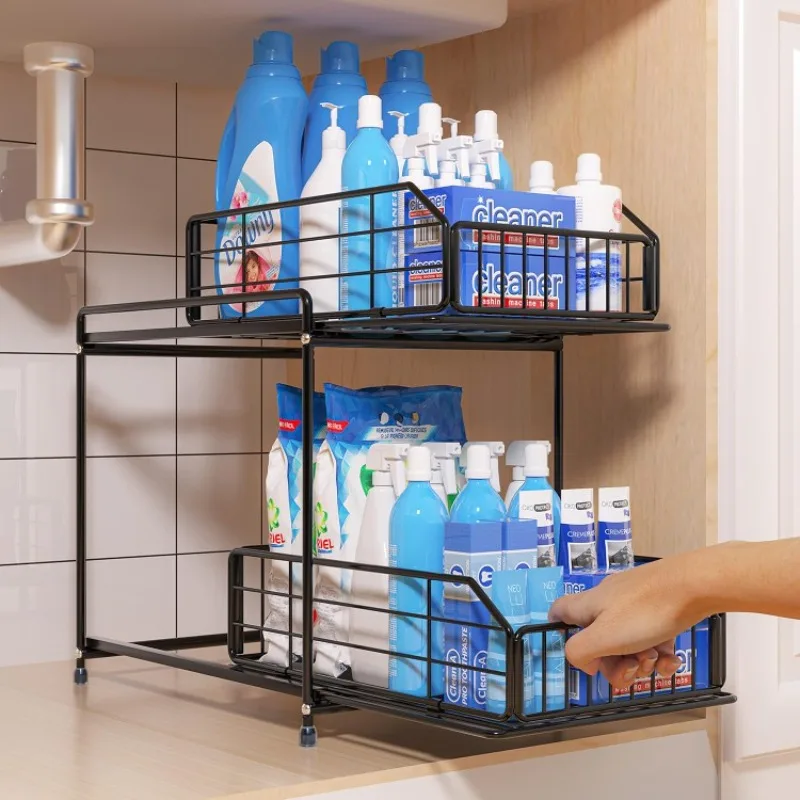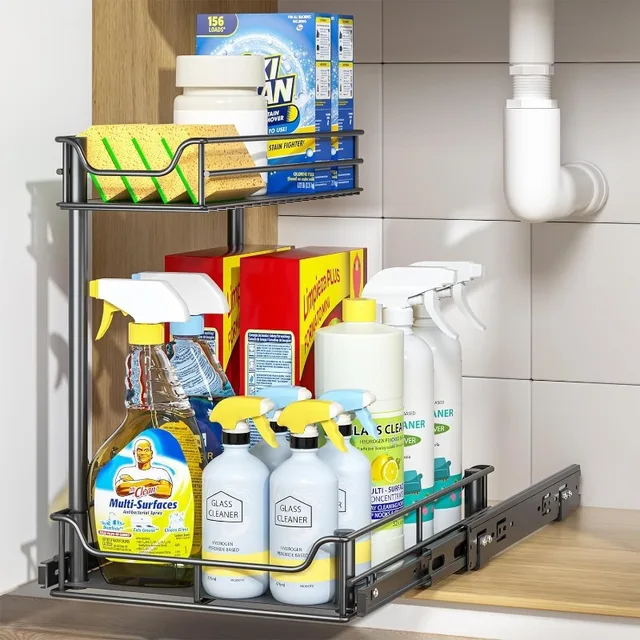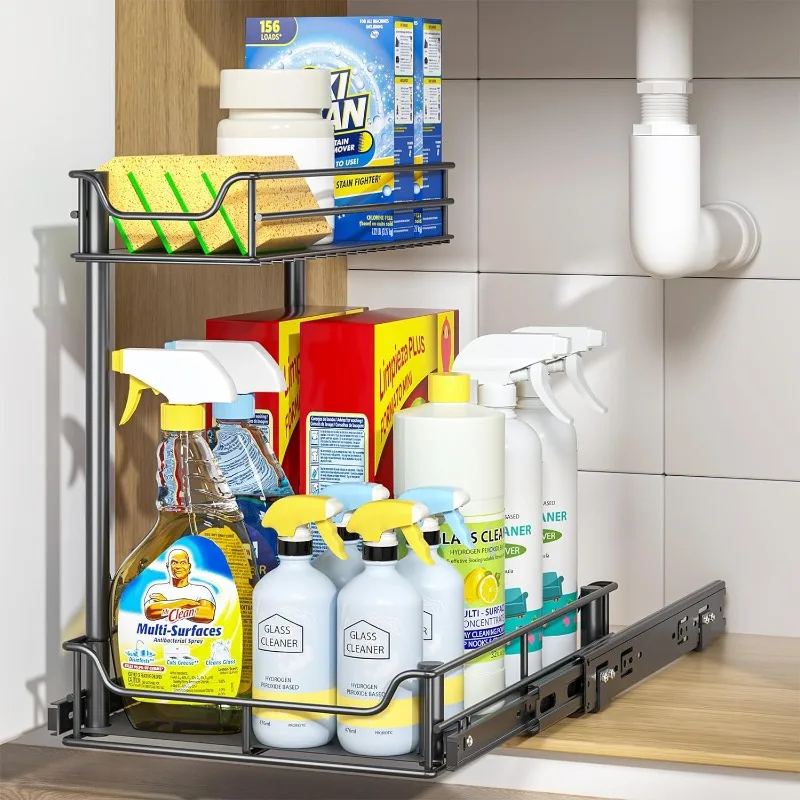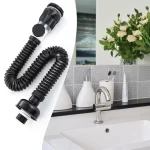How to Organize Under Kitchen Sink: Maximizing Space and Efficiency
The area under the kitchen sink often becomes a cluttered mess due to its convenient location for storing cleaning supplies, trash bags, and other essentials. However, with a strategic approach to organization, you can transform this space into an efficient storage area that enhances your kitchen’s functionality and aesthetics.
Assessing Your Storage Needs
Before diving into organizing, take stock of what you store under your kitchen sink. This typically includes cleaning products, dishwashing supplies, trash bags, and sometimes even small kitchen appliances like garbage disposals or water filters. Assessing your storage needs helps you determine the types of organizers and containers required to streamline the space.
Decluttering and Sorting
The first step to effective organization is decluttering. Empty out everything from under the sink and sort items into categories such as cleaning products, dishwashing supplies, and miscellaneous items. Discard expired or unused items, consolidate duplicates, and relocate items that don’t belong there to free up space for essentials.

Choosing the Right Organizers
Investing in the right organizers is key to maximizing space under the kitchen sink. Opt for adjustable shelving units to accommodate items of different heights. Utilize stackable bins or baskets to categorize and store cleaning supplies efficiently. Lazy Susans or turntables are ideal for accessing items stored at the back without rummaging through everything.
Utilizing Vertical Space
Make use of vertical space by installing tension rods or hooks inside the cabinet doors. These can hold spray bottles, gloves, or dish towels, keeping them easily accessible yet out of the way. Hanging baskets or wire racks can also be mounted on the inside of cabinet doors to store smaller items like sponges or scrub brushes.
Containerizing and Labeling
Once you’ve sorted and selected your organizers, containerize loose items to prevent clutter. Clear bins or baskets are ideal for storing grouped items such as kitchen towels, trash bags, or dishwasher pods. Label containers to quickly identify contents and maintain an organized system over time.
Managing Plumbing Obstacles
Under-sink storage often comes with plumbing obstacles like pipes and garbage disposal units. Utilize the space around these obstacles by opting for adjustable shelves or organizers specifically designed to fit around pipes. Consider utilizing stackable drawers or bins that can be easily maneuvered to access items without disrupting plumbing.
Implementing Maintenance Routines
Maintaining an organized space under the kitchen sink requires regular upkeep. Schedule routine checks to ensure items remain organized and discard expired products promptly. Wipe down shelves and organizers periodically to prevent dust buildup and spills from becoming sticky messes.

Incorporating Safety Measures
If you have children or pets, it’s crucial to incorporate safety measures when organizing under the kitchen sink. Store hazardous cleaning products in locked or child-proof containers. Keep sharp objects or potentially harmful chemicals out of reach by placing them on higher shelves or behind childproof cabinet locks.
Enhancing Accessibility and Convenience
Lastly, prioritize accessibility and convenience when organizing under the kitchen sink. Store frequently used items within easy reach and less frequently used items towards the back or higher shelves. Consider installing pull-out drawers or organizers that extend fully for effortless access to items stored at the back of the cabinet.
Creating a DIY Cleaning Station
Transform the space under your kitchen sink into a functional DIY cleaning station. This approach not only organizes your cleaning supplies but also makes it easier to access everything you need for routine cleaning tasks.
Grouping Cleaning Supplies
Begin by grouping your cleaning supplies into categories such as glass cleaners, surface disinfectants, dish soaps, and scrubbing tools. Use stackable bins or baskets to contain each category, making it easy to pull out the entire bin when you need to clean.
Labeling Containers
Labeling containers is essential for maintaining an organized cleaning station. Clearly mark each bin or basket with the type of supplies it holds, ensuring everyone in the household knows where to find and return items. This simple step helps prevent clutter and confusion over time.
Utilizing Hooks and Holders
Install hooks or adhesive holders on the inside of the cabinet door to store cleaning tools such as scrub brushes, squeegees, or gloves. This not only frees up shelf space but also keeps these items within easy reach whenever you need them.

Incorporating a Drip Tray
To protect your cabinet from leaks or spills, place a drip tray or mat at the bottom of the cabinet under the cleaning supplies. Choose a tray that’s easy to clean or absorbent enough to contain any liquid, ensuring your cabinet remains clean and dry.
Organizing Trash and Recycling
If your kitchen waste bins are stored under the sink, consider using a sliding organizer or drawer system for easy access. Separate bins for trash and recycling can help streamline waste disposal and make it convenient to empty bins when full.
Customizing to Your Needs
Customize your DIY cleaning station based on your household’s needs and preferences. If you have pets, allocate space for pet-specific cleaning supplies. For eco-conscious households, designate an area for reusable cleaning cloths or environmentally friendly cleaning products.
Maintaining Order
Regularly assess and declutter your cleaning station to keep it organized. Dispose of empty containers or expired products promptly, and restock essentials as needed to ensure you’re always prepared for cleaning tasks.
Organizing Under Kitchen Sink for Non-Cleaning Supplies
While cleaning supplies often dominate the space under the kitchen sink, there are other ways to effectively utilize this area for storage beyond cleaning products. Here’s how to organize and optimize under your kitchen sink for various non-cleaning items:
Storing Kitchen Linens and Towels
Utilize the space under the sink to store kitchen linens such as dish towels, cloth napkins, or aprons. Roll or fold them neatly and place them in bins or baskets for easy access. Consider using dividers or adjustable shelves to keep different types of linens organized and separated.
Organizing Extra Supplies
Store extra supplies that you frequently use in the kitchen, such as paper towels, trash bags, or disposable gloves, under the sink. Use bins or baskets to keep these items contained and easily accessible. Labeling containers can help you quickly locate what you need.
Housing Small Kitchen Appliances
If space permits, consider storing small kitchen appliances under the sink, such as a compact food processor, blender, or mixer. Use stackable bins or shelves to create a designated area for these appliances, ensuring they’re stored securely and protected from moisture.
Managing Household Essentials
Organize household essentials like light bulbs, batteries, or tool kits under the kitchen sink. Use small containers or compartments to keep these items sorted and easily retrievable when needed. Labeling or color-coding containers can help you quickly identify specific essentials.
Creating a Garden or Plant Care Station
If you enjoy indoor gardening or caring for houseplants, designate part of the space under the sink for gardening supplies. Store items such as plant fertilizers, watering cans, or gardening gloves in bins or baskets. Consider adding hooks for hanging small gardening tools or plant misters.
Protecting Items from Moisture
To protect non-cleaning items from moisture or leaks, consider using waterproof bins or containers under the sink. Place a moisture-absorbing mat or tray at the bottom of the cabinet to catch any spills and keep the interior clean and dry.
Conclusion
By following these practical tips and strategies, you can transform the space organize under kitchen sink into a well-organized and efficient storage area. Maximizing space and efficiency not only enhances your kitchen’s functionality but also simplifies your daily routines by ensuring everything you need is readily accessible and neatly stored. With the right organizers, regular maintenance, and a systematic approach to storage, you’ll enjoy a clutter-free and organized kitchen for years to come.


